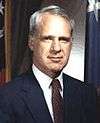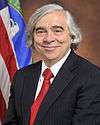United States Secretary of Energy
The United States secretary of energy is the head of the United States Department of Energy, a member of the Cabinet of the United States, and fifteenth in the presidential line of succession. The position was formed on October 1, 1977 with the creation of the Department of Energy when President Jimmy Carter signed the Department of Energy Organization Act.[2] Originally the post focused on energy production and regulation. The emphasis soon shifted to developing technology for better and more efficient energy sources as well as energy education. After the end of the Cold War, the department's attention also turned toward radioactive waste disposal and maintenance of environmental quality.[3] The current secretary of energy is Dan Brouillette.[4][5]
| United States Secretary of Energy | |
|---|---|
 Seal of the Department | |
 Flag of the Secretary | |
.jpg) Dan Brouillette since December 4, 2019 | |
| United States Department of Energy | |
| Style | Mr. Secretary |
| Member of | Cabinet National Security Council |
| Reports to | President of the United States |
| Seat | James V. Forrestal Building, Washington, D.C. |
| Appointer | The President with Senate advice and consent |
| Term length | No fixed term |
| Constituting instrument | 42 U.S.C. § 7131 |
| Formation | August 6, 1977 |
| First holder | James R. Schlesinger |
| Succession | Fifteenth[1] |
| Deputy | Deputy Secretary of Energy |
| Salary | Executive Schedule, level I |
| Website | Energy.gov |
Former secretary of defense James Schlesinger was the first secretary of energy, who was a Republican nominated to the post by Democratic president Jimmy Carter, the only time a president has appointed someone of another party to the post. Schlesinger is also the only secretary to be dismissed from the post.[6] Hazel O'Leary, Bill Clinton's first secretary of energy, was the first female and African-American holder.[7] The first Hispanic to serve as Energy Secretary was Clinton's second, Federico Peña.[8] Spencer Abraham became the first Arab American to hold the position on January 20, 2001, serving under the administration of George W. Bush. Steven Chu became the first Asian American to hold the position on January 20, 2009, serving under the administration of Barack Obama. He is also the longest-serving secretary of energy and the first individual to join the Cabinet having received a Nobel Prize.
List of secretaries of energy
- Parties
Democratic (6) Republican (9)
| No. | Portrait | Name | State of Residence | Took office | Left office | Party | President(s) | |
|---|---|---|---|---|---|---|---|---|
| 1 |  |
James Schlesinger | Virginia | August 6, 1977 | August 23, 1979 | Republican | Jimmy Carter | |
| 2 | .jpg) |
Charles Duncan | Texas | August 24, 1979 | January 20, 1981 | Democratic | ||
| 3 |  |
James Edwards | South Carolina | January 23, 1981 | November 5, 1982 | Republican | Ronald Reagan | |
| 4 | Donald Hodel | Oregon | November 5, 1982 | February 7, 1985 | Republican | |||
| 5 |  |
John Herrington | California | February 7, 1985 | January 20, 1989 | Republican | ||
| 6 |  |
James Watkins | California | March 1, 1989 | January 20, 1993 | Republican | George H. W. Bush | |
| 7 |  |
Hazel O'Leary | Virginia | January 22, 1993 | January 20, 1997 | Democratic | Bill Clinton | |
| 8 |  |
Federico Peña | Colorado | March 12, 1997 | June 30, 1998 | Democratic | ||
| 9 |  |
Bill Richardson | New Mexico | August 18, 1998 | January 20, 2001 | Democratic | ||
| 10 |  |
Spencer Abraham | Michigan | January 20, 2001 | February 1, 2005 | Republican | George W. Bush | |
| 11 |  |
Samuel Bodman | Illinois | February 1, 2005 | January 20, 2009 | Republican | ||
| 12 |  |
Steven Chu | California | January 20, 2009 | April 22, 2013 | Democratic | Barack Obama | |
| – |  |
Daniel Poneman | Ohio | April 22, 2013 | May 21, 2013 | Democratic | ||
| 13 |  |
Ernest Moniz | Massachusetts | May 21, 2013 | January 20, 2017 | Democratic | ||
| – |  |
Grace Bochenek | January 20, 2017 | March 2, 2017 | Donald Trump | |||
| 14 | .jpg) |
Rick Perry | Texas | March 2, 2017 | December 1, 2019 | Republican | ||
| 15 | .jpg) |
Dan Brouillette | Texas | December 1, 2019 | December 4, 2019 | Republican | ||
| December 4, 2019 | Incumbent | |||||||
Living former secretaries of energy
As of April 2020, there are ten living former secretaries of energy, the oldest being Charles Duncan Jr. (served 1979–1981, born 1926). The most recent secretary of energy to die was Samuel Bodman (served 2005–2009, born 1938) on September 7, 2018.
| Name | Term | Date of birth (and age) |
|---|---|---|
| Charles Duncan Jr. | 1979–1981 | September 9, 1926 |
| Donald Hodel | 1982–1985 | May 23, 1935 |
| John S. Herrington | 1985–1989 | May 31, 1939 |
| Hazel O'Leary | 1993–1997 | May 17, 1937 |
| Federico Peña | 1997–1998 | March 15, 1947 |
| Bill Richardson | 1998–2001 | November 15, 1947 |
| Spencer Abraham | 2001–2005 | June 12, 1952 |
| Steven Chu | 2009–2013 | February 28, 1948 |
| Ernest Moniz | 2013–2017 | December 22, 1944 |
| Rick Perry | 2017–2019 | March 4, 1950 |
See also
- List of living former members of the United States Cabinet
- United States Secretary of Transportation
- White House Office of Energy and Climate Change Policy
References
- "3 U.S. Code § 19 - Vacancy in offices of both President and Vice President; officers eligible to act | US Law | LII / Legal Information Institute". Law.cornell.edu. Retrieved June 14, 2017.
- "Origins". U.S. Department of Energy. Archived from the original on July 12, 2007. Retrieved July 29, 2007.
- "The Clinton Administration". The Washington Post. February 18, 2000. Retrieved July 29, 2007.
- Bowden, John (December 1, 2019). "Perry ends final day as Energy secretary". The Hill. Retrieved December 2, 2019.
- https://twitter.com/AnthonyAdragna/status/1201640955377524741
- "Biography of James Schlesinger Origins". U.S. Department of Defense. Retrieved August 13, 2007.
- "President Hazel R. O'Leary Honored by Urban League". Fisk University. Archived from the original on September 27, 2007. Retrieved August 13, 2007.
- "Federico F. Peña to be Sworn in as the Eighth Secretary of Energy". U.S. Department of Energy. Archived from the original on September 29, 2007. Retrieved August 13, 2007.
External links
| U.S. order of precedence (ceremonial) | ||
|---|---|---|
| Preceded by Elaine Chao as Secretary of Transportation |
Order of Precedence of the United States as Secretary of Energy |
Succeeded by Betsy DeVos as Secretary of Education |
| U.S. presidential line of succession | ||
| Preceded by Secretary of Housing and Urban Development Ben Carson |
15th in line | Succeeded by Secretary of Education Betsy Devos |